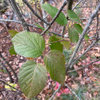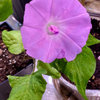Info on Aristolochia durior x elegans
This is similar to a recent post I made on the Butterfly forum, with essentially the same questions.
I recently bought a 1 gallon plant at UC Botanical Garden (Berkeley) labeled Aristolochia durior x elegans:
{{gwi:550053}}
Here's the tag that came with it:
{{gwi:550052}}
I was intrigued as A. durior is typically given as a zone 4 plant. A. elegans is usually given as zone 8 or zone 9, although in California it's usually sold as hardy to 25 F.
I was also surprised at the size given for the flowers. A. elegans is usually given as 3, sometimes as large as 4 inches. A. durior is smaller.
Interestingly, there are irregular white spots on the leaves. I was under the impression these are characteristic of A. gigantea and not its close relative A. elegans. If someone knows differently, please correct me.
{{gwi:550054}}
So I'm looking for any information I can find on this hybrid. I've already spoken with people at UCBG. Some specific questions:
What is the history of this hybrid (I remember seeing it on the UCBG website at least a couple years ago)?
Has anyone tested the hardiness? Presumably the person who made the hybrid had this in mind.
Could A. gigantea instead of A. elegans be one of the parents (based on flower size and leaf coloration)?
Of course any other comments or questions about the hybrid would also be welcome. I don't have any photos of the flowers. There are a couple online, I give a link below. I've already started trying to root couple cuttings and expect to start more in the Spring.
Here is a link that might be useful: A site with pictures of this plant's flowers









Gerris2 (Joseph Delaware Zone 7a)
TimChapman
Related Professionals
Bellflower Landscape Architects & Landscape Designers · Forest Acres Landscape Architects & Landscape Designers · McKinney Landscape Contractors · Canyon Lake Landscape Contractors · Gaithersburg Landscape Contractors · Gloucester Landscape Contractors · Matteson Landscape Contractors · Petaluma Landscape Contractors · Ronkonkoma Landscape Contractors · San Antonio Landscape Contractors · San Rafael Landscape Contractors · Suitland Landscape Contractors · Whitehall Landscape Contractors · Bensenville Landscape Contractors · Dent Stone, Pavers & ConcreteDzitmoidonc
TimChapman
Dzitmoidonc
aristolo
mark4321_gwOriginal Author